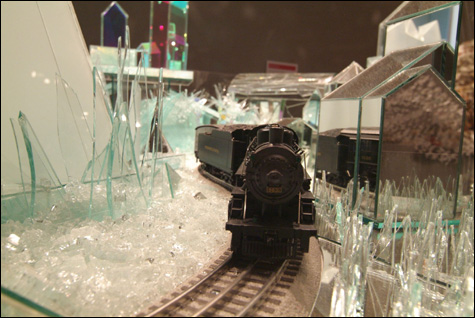Trains at the DeCordova, the Kabakovs’ Utopia at Tufts
By GREG COOK | September 18, 2007

HERE, THERE, AND EVERYWHERE: Joy Wulke’s twinkling landscape recalls Superman’s icy Fortress
of Solitude. |
The DeCordova Museum’s “Trainscape: Installation Art for Model Railroads” is a great, wild, flawed 14-artist circus. Your first sights from the gallery entrance are dangling cartoon clouds, a giant gent in a stovepipe hat, mini mountains, cascading white buildings, pink petals floating in midair. There’s lots of motion as four trains clickety-click out from the center of the room and circulate through 12 installations commissioned by curator Nick Capasso and company. My first reaction wasn’t much different from that of the little girl I overheard exclaim, “This is awesome!”A sculpture by Marshfield’s George Greenamyer looms over you — and it seems innocent enough. A man rendered in a folksy style, in what looks like papier-mâché, with big gray sideburns and a black stovepipe hat and suit, sits at a table staring with big blank eyes at a cartoony sack of money. A toy freight train runs between his legs, underneath the table, past a sign that reads, “Cornelius Vanderbilt (1794–1877) Chief Rogue of the Railroad Robber Barons,” before looping around and coming back again. Greenamyer paints quotations around the edge of the table: “You have undertaken to cheat me. I won’t sue you, for the law is too slow. I will ruin you.” And “What do I care about law? Ain’t I got the power?” It’s a blunt thwack, reminding us that trains ain’t all fun and imagination, but also that tycoons had so much money and power that the world could be like a toy to them.
The train chugs on through Fitchburg couple Ellen Wetmore & Jeff “Jeffu” Warmouth’s Land o’ Lactation, winding across a causeway above a milky lake poured between realistically rendered mountains. The peaks, though, resemble breasts, with milky fluid trickling from their tips down to the lake below. The piece was inspired by the recent arrival of the couple’s son. “Shortly after Alexander’s birth,” a wall text explains, “Wetmore remarked that her life was being taken over by her breasts.” This affords satirist Warmouth, who is unable to resist a cheesy joke, fertile territory (“Mozzarella Mine: Danger Falling Cheese”). It’s all too goofy to get me thinking deep thoughts about the nourishing earth, as another wall text suggests, but it does bring to mind the Grand Tetons in Wyoming, which some think were named by a French trapper who thought the peaks looked like a lady’s, uh, tetons. You’ve got to hand it to the French; hereabouts people looked at mountains and saw only the profiles of old men.
Capasso in another wall text explains that the exhibition addresses the “vital issue” of contemporary artists inventing imaginary worlds and alternative realities — partly as an escape from our actual nervous world. It is a significant trend, but the explanation feels tacked on. The triumph of “Trainscape” is its entertaining playfulness. Some big ideas are batted about, with varying degrees of success, but the overriding spirit is fun. There are lots of groaner puns, maybe too many. Still, it’s when the artists here get too earnest and arty that they falter. The contrast with the toy trains makes such attitudes feel particularly precious and pretentious.
 Topics
Topics:
Museum And Gallery
, Entertainment, Culture and Lifestyle, Ilya Kabakov, More  , Entertainment, Culture and Lifestyle, Ilya Kabakov, Tufts University, Hobbies and Pastimes, Performing Arts, Visual Arts, Cultural Institutions and Parks, Museums, DeCordova Museum, Less
, Entertainment, Culture and Lifestyle, Ilya Kabakov, Tufts University, Hobbies and Pastimes, Performing Arts, Visual Arts, Cultural Institutions and Parks, Museums, DeCordova Museum, Less 